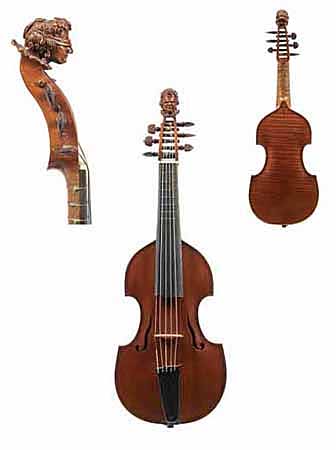
Owner: HWMC
Catalog#: 2CL-CHLT-116
Provenance: The Richard W. and Jeannine E. Abel Musical Instrument Collection
Violin Family
Viola d'Amore - Gamba Form
Italy
European
Wood, gut strings, pearl, bone
ca. late 1700s – early 1800s
Length: 14.4 inches (Back)
Strings – Lutes – Violin Family
Viola d’Amore, unlabeled
The viola d’amore shares many features of the viol family, a bowed box-lute chordophone of Renaissance Europe.
This viola d’amore is in the gamba form with 6-strings and no sympathetic strings. The viola d’amore was chiefly played in the baroque period. It is played under the chin, much in the same manner as the violin/viola. The sound holes are a special feature of the viola d’amore. In contrast to the C of the gamba and the F-holes of the violins, they are serpentine- or flame-shaped. An intricately carved head of a blindfold cupid with circular ruffled collar is at the top of the peg box, representing the blindness of love.
The origin of the viola d´amore is unknown, but the earliest mention of the name viola d´amore implies that these instruments had different tunings. Thus, the viola d´amore had no fixed tuning like the violin (fifths). The tuning chord was, especially in the 17th-18th centuries, based on the key of the piece.
Resource: https://omeka-s.grinnell.edu/s/MusicalInstruments/item/638
